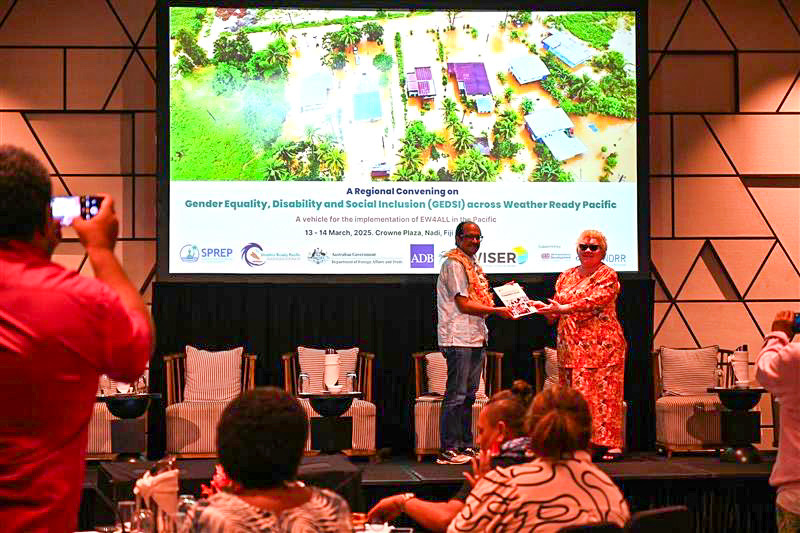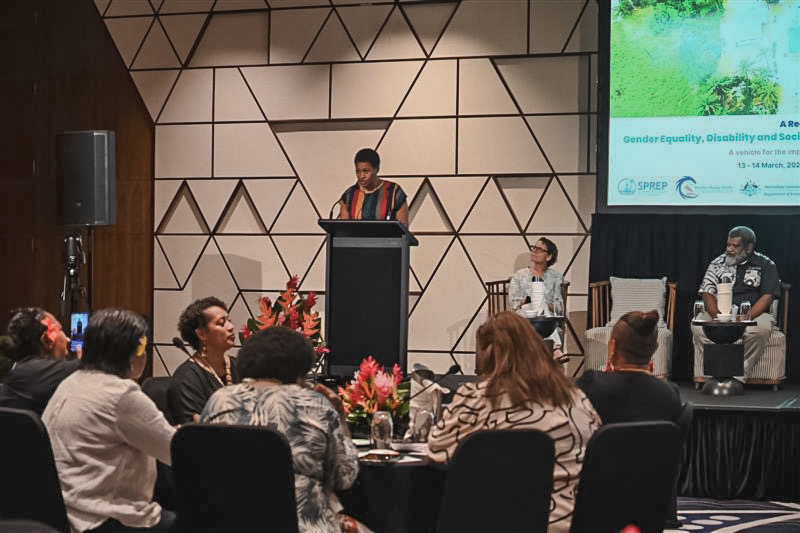
Nadi, Fiji (14 March, 2025) – A well-attended regional convening was held over two days in Nadi, with the aim to provide insights from Pacific women’s movement, Pacific organisations of persons with disabilities (OPDs), the church and faith-based organisations, and broader civil society, help provide contextual and national insights for an inclusive co-designed and co-created pathway of mainstreaming Gender Equality, Disability and Social Inclusion (GEDSI) into Weather Ready Pacific’s (WRP) decadal programming.
“This convening is a crucial step towards making tangible progress in integrating GEDSI into Early Warning preparedness and response in the Pacific,” said Mr. Salesa Nihmei, Officer-in-Charge of the Climate Science and Information Programme at SPREP.
Weather Ready Pacific’s strategic objective is to ensure communities, government and industries have the systems, forecasts, warnings and information to enact response plans to extreme weather events and in a timely manner.
.jpg)
Immediately alongside H.E. Kishore are Mrs. Sainimili Tawake, CEO of the Pacific Disability Forum (left) and Mr. Salesa Nihmei, Officer-in-charge of the Climate Science and Information Programme at SPREP (right).
In setting the scene for the convening, Mrs. Sainimili Tawake, CEO of Pacific Disability Forum, stressed the importance of inclusion in every aspect of society. “We are not vulnerable. We (persons with disabilities) are part of groups and communities like everyone else. It is the communities and society that we are a part of, that make us vulnerable,” she said.
The regional convening on GEDSI was facilitated by Mrs. Susana Naisara, GEDSI Advisor for Weather Ready Pacific, who skilfully garnered insightful feedback from the participants, to deepen discussions on challenges and opportunities in the region and beyond.

Mr. Nihmei further explained, “The statistics speak for themselves, and we know that disasters in the Pacific region disproportionately affect vulnerable groups, including women, the elderly, children, and persons with disabilities. Reports from our regional partners prove that Women and children are 14 times more likely than men to die or be injured in a disaster and that children with disabilities in the Pacific are two to four times more likely to be killed or injured during a disaster."
The 2009 Samoa tsunami highlighted this reality with elderly individuals struggling to escape, leading to higher fatality rates. In Tonga, all nine lives lost were among women, the elderly, and children. During Tropical Cyclone Pam in 2015, 74% of women with disabilities and 50% of men with disabilities reported barriers to accessing evacuation centers.
In the latter part of Day One, the Special Representative of the United Nations Secretary-General (SRSG) for Disaster Risk Reduction, and Head of the United Nations Office for Disaster Risk Reduction (UNDRR) – H.E Kamal Kishore joined the regional convening and congratulated the Pacific region for developing the WRP Programme well before the Early Warnings For All (EW4All) was rolled out globally.
“When we launched the EW4All, Weather Ready Pacific was already conceptualised and well in progress. The world is talking about disability, inclusion and disaster resilience efforts and we’ve been talking about it for quite some time but to come here and to witness the Pacific Disability Forum launch their 10-year strategy is impressive,” said H.E. Kishore.
“So you really are the torch bearers of some of the most leading-edge discussions on how to rebuild societal resilience.”
H.E. Kishore outlined a few key interventions that could potentially accelerate the progress of implementing Multi Hazard Early Warnings (MHEWS). He recommended that NMHSs need to genuinely consider the needs of the users, improve understanding of cascading hazards where one hazard leads to another, create an environment for private sector engagement for sustainable resource mobilisation, treat the whole earth system as one in terms of addressing geohazards and HydroMet hazards and the intelligent use of innovative ICT technologies to reduce costs.

The convening ended on 14 March, with a session on consolidating outcomes and discussions into the WRP Pathway of Implementation.